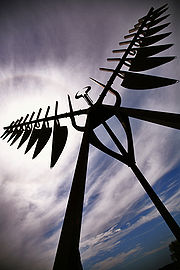
Spirit Catcher
Encyclopedia


Expo 86
The 1986 World Exposition on Transportation and Communication, or simply Expo '86, was a World's Fair held in Vancouver, British Columbia, Canada from Friday, May 2 until Monday, October 13, 1986...
in Vancouver
Vancouver
Vancouver is a coastal seaport city on the mainland of British Columbia, Canada. It is the hub of Greater Vancouver, which, with over 2.3 million residents, is the third most populous metropolitan area in the country,...
, British Columbia
British Columbia
British Columbia is the westernmost of Canada's provinces and is known for its natural beauty, as reflected in its Latin motto, Splendor sine occasu . Its name was chosen by Queen Victoria in 1858...
, Canada
Canada
Canada is a North American country consisting of ten provinces and three territories. Located in the northern part of the continent, it extends from the Atlantic Ocean in the east to the Pacific Ocean in the west, and northward into the Arctic Ocean...
. It is now situated on the shore of Kempenfelt Bay
Kempenfelt Bay
Kempenfelt Bay is a 14.5 km long bay that leads into the Canadian city of Barrie, Ontario. It is as deep as 30 m in places, and is connected to the larger Lake Simcoe...
, in Barrie
Barrie, Ontario
Barrie is a city in Southern Ontario, Canada, located on the western shore of Lake Simcoe, approximately 90 km north of Toronto. Although located in Simcoe County, the city is politically independent...
, Ontario
Ontario
Ontario is a province of Canada, located in east-central Canada. It is Canada's most populous province and second largest in total area. It is home to the nation's most populous city, Toronto, and the nation's capital, Ottawa....
, Canada
Canada
Canada is a North American country consisting of ten provinces and three territories. Located in the northern part of the continent, it extends from the Atlantic Ocean in the east to the Pacific Ocean in the west, and northward into the Arctic Ocean...
.
Nine sculptors were asked to submit proposals for Expo 86
Expo 86
The 1986 World Exposition on Transportation and Communication, or simply Expo '86, was a World's Fair held in Vancouver, British Columbia, Canada from Friday, May 2 until Monday, October 13, 1986...
, and two were chosen to be commissioned. The sculpture took six months to sculpt using COR-TEN
Cor-ten
Weathering steel, best-known under the trademark COR-TEN steel and sometimes written without the hyphen as "Corten steel", is a group of steel alloys which were developed to eliminate the need for painting, and form a stable rust-like appearance if exposed to the weather for several years.United...
steel
Steel
Steel is an alloy that consists mostly of iron and has a carbon content between 0.2% and 2.1% by weight, depending on the grade. Carbon is the most common alloying material for iron, but various other alloying elements are used, such as manganese, chromium, vanadium, and tungsten...
; this alloy develops a non-corrosive oxide and retains its structural integrity. The work was originally installed on the Expo 86
Expo 86
The 1986 World Exposition on Transportation and Communication, or simply Expo '86, was a World's Fair held in Vancouver, British Columbia, Canada from Friday, May 2 until Monday, October 13, 1986...
exhibition grounds in Vancouver, British Columbia.
After the end of the exposition, the sculpture was purchased by the Helen McCrea Peacock Foundation in Toronto for CAD
Canadian dollar
The Canadian dollar is the currency of Canada. As of 2007, the Canadian dollar is the 7th most traded currency in the world. It is abbreviated with the dollar sign $, or C$ to distinguish it from other dollar-denominated currencies...
$230,000. The foundation then donated the sculpture to the 'Barrie Gallery Project' as an inspiration to create an art gallery in the city of Barrie, Ontario
Barrie, Ontario
Barrie is a city in Southern Ontario, Canada, located on the western shore of Lake Simcoe, approximately 90 km north of Toronto. Although located in Simcoe County, the city is politically independent...
, Canada
Canada
Canada is a North American country consisting of ten provinces and three territories. Located in the northern part of the continent, it extends from the Atlantic Ocean in the east to the Pacific Ocean in the west, and northward into the Arctic Ocean...
. The twenty ton, 25 m (70 ft) wide by 21 m (65 ft) tall sculpture was transported to Barrie using two flatbed trucks, and was installed by volunteers and two cranes. It took two days during the weekend of 12 June and 13 June 1987, and was dedicated on 12 September 1987.
The sculpture has 16 kinetic quills, which rock back and forth when the wind blows. Several months after it was erected on the site in Barrie, the unpredictable winds coming onshore from Kempenfelt Bay
Kempenfelt Bay
Kempenfelt Bay is a 14.5 km long bay that leads into the Canadian city of Barrie, Ontario. It is as deep as 30 m in places, and is connected to the larger Lake Simcoe...
caused concern that the quills might fall off. The quills were redesigned by the artist with the assistance of Mike Davies, the recently retired vice president of advanced engineering at de Havilland aircraft
De Havilland
The de Havilland Aircraft Company was a British aviation manufacturer founded in 1920 when Airco, of which Geoffrey de Havilland had been chief designer, was sold to BSA by the owner George Holt Thomas. De Havilland then set up a company under his name in September of that year at Stag Lane...
.
The sculpture is a focal point on the Barrie waterfront, and serves as both a meeting place and navigational aid to travellers and citizens of the city alike. The installation of the sculpture initiated a drive to place numerous pieces of art around the city which continues to this day.

